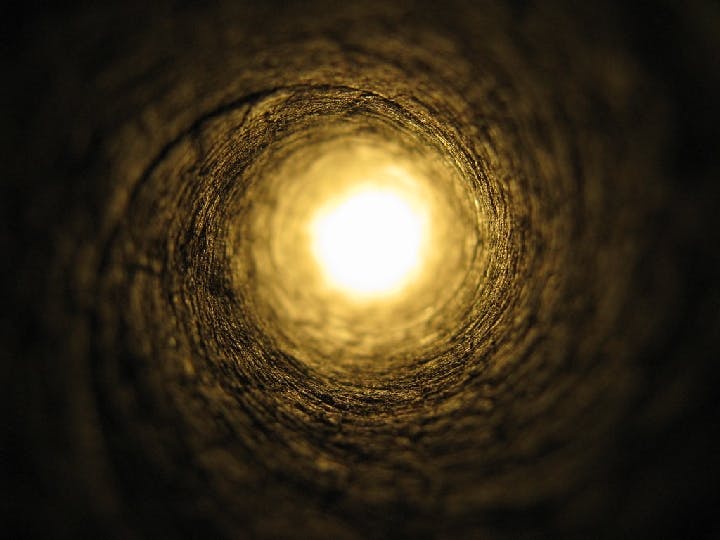Summer 2008
The Holy Web
– Mary Swander
Mary Swander on pantheism and the epiphany of Sharman Apt Russell.
Twelve years ago, Sharman Apt Russell sat down on her porch in Silver City, New Mexico, and decided to become a Quaker. For Russell, adopting the Quaker religion meant not only joining a group of like-minded people whose traditions include pacifism and a commitment to right the wrongs in the Peaceable Kingdom, but finding her own definition of “standing in the Light.” Her group consists of unprogrammed Quakers and Universalists. They have no minister, no creed, no scripture. Rather, they gather in silence, “waiting—waiting for the Light.”
On her porch steps, Russell had an epiphany. She found her Light in pantheism. In middle age, with her children growing up, instilled with a sense of her own mortality by her father’s early death, Russell embarked on a spiritual quest to practice and more clearly define a belief system that falls under the umbrella of paganism—any nontheistic belief that is not Christian, Jewish, or Muslim. But isn't pantheism just a New Age belief in tree spirits? Russell’s friends asked. Isn't it mysticism with an experience of the supernatural? Russell answers these questions and others in her investigation of this little-understood belief.
Pantheists include a wide spectrum of thinkers—from the Greek physici philosophers, to practitioners of Eastern religions, to dualists, to Romantic poets, to contemporary deep ecologists and cell biologists. But the basic belief is that “the universe is an interrelated whole that deserves human reverence.” In the words of the Roman emperor and Stoic philosopher Marcus Aurelius, “Everything is interwoven, and the web is holy.” As part of that web, Russell says, we are “called upon to celebrate our existence in the universe, no matter what and who we are, blessed or not, whole or broken, deserving or undeserving.”
Throughout her exploration of spiritual thought, she interweaves a narrative of her work as a naturalist. Her observations of herds of javelina, of stinkbugs and coots, and of birds she bands for the Nature Conservancy deftly illustrate her sensitive yet unsentimental connection to the holy web. Through binoculars Russell watches sandhill cranes, the oldest known living bird species, and waits for the female crane to dance, but “with wings fully extended, she springs upward, flapping strongly, the upstroke more rapid than the down as she gains altitude.” The transitions between Russell’s theological writing and her personal observations of nature can be abrupt. But the material is compelling, and we always feel that we are in good hands with Russell, who has written with authority of the natural world in previous books, most recently Hunger: An Unnatural History (2005).
Yet in Standing in the Light, the nature writing plays a supporting role to human biography. Russell is at her best when she focuses on portraits of Marcus Aurelius, Baruch Spinoza, and Walt Whitman, all pantheistic writers. Even when faced with a besieged empire and the death of nine of his 14 children, Marcus Aurelius (ad 121–180) acknowledged a beneficent universe and his role in it. Spinoza (1632–77), exiled from his Jewish community for beliefs that, in the words of an Augustinian monk reporting to the Spanish Inquisition, “reached the point of atheism,” lived out his days in a rented room in Holland, grinding glass for lenses. His posthumously published masterpiece Ethics offered what Spinoza saw as a logical “geometric proof” that God was identical with nature. Like Spinoza and other pantheists whose ideas contradict the dominant culture, Whitman (1819–92), a Transcendentalist, was disparaged in his time. In Leaves of Grass (1855), he sought to write a uniquely American poetry that celebrated humanity and the natural world.
In the large sweep of this book, Russell shows us the variety of Western thought on the holy web through the voices of D. H. Lawrence, Robinson Jeffers, Virginia Woolf, and Annie Dillard. And she investigates the many rich Eastern traditions, including Hinduism and Buddhism, that embrace the call to celebrate the spirituality of the present moment. She widens the lens of her binoculars so that we, too, may see the cranes dance. But she ends not with the excitement of that sight, but with the act of opening the door to her little yellow house to reveal her serene faith in the wonders of her place on the earth.
* * *
Mary Swander is a Distinguished Professor of Liberal Arts and Sciences at Iowa State University. She is the author of 11 books of poetry and nonfiction, most recently a memoir, The Desert Pilgrim: En Route to Mysticism and Miracles (2003), and a collection of poetry, The Girls on the Roof, which is forthcoming next year.
Reviewed: "Standing in the Light: My Life as a Pantheist" by Sharman Apt Russell, Basic, 2008.
Photo courtesy of Flickr/Sam Bald
Up next in this issue
